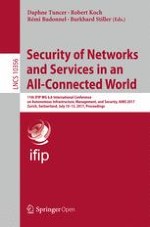Open Access 2017 | Open Access | Buch

Security of Networks and Services in an All-Connected World
11th IFIP WG 6.6 International Conference on Autonomous Infrastructure, Management, and Security, AIMS 2017, Zurich, Switzerland, July 10-13, 2017, Proceedings
herausgegeben von: Daphne Tuncer, Robert Koch, Rémi Badonnel, Prof. Dr. Burkhard Stiller
Verlag: Springer International Publishing
Buchreihe : Lecture Notes in Computer Science